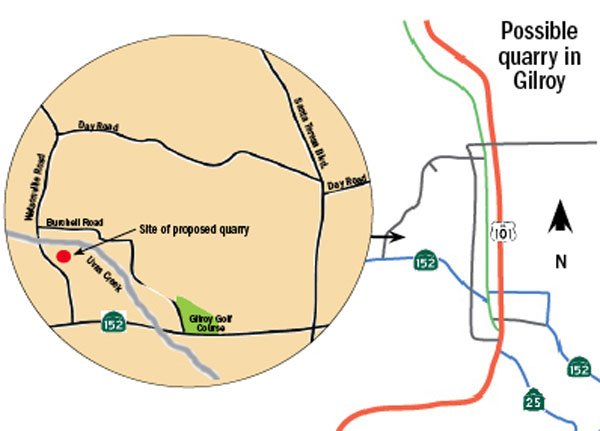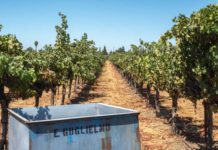The developers behind a proposed quarry-cum-neighborhood project
northeast of Gilroy will file a redesigned application with the
county planning office by month’s end, but ardent residents have
grouped to develop a sophisticated battle plan to preserve the
pristine environment: One has already been to Sacramento to voice
her opposition, and the growing, web-savvy cohort even has
anti-quarry bumper stickers for sale.
The developers behind a proposed quarry-cum-neighborhood project northwest of Gilroy will file a redesigned application with the county planning office by month’s end, but ardent residents have grouped to develop a sophisticated battle plan to preserve the pristine environment: One has already been to Sacramento to voice her opposition, and the growing, web-savvy group even has anti-quarry bumper stickers for sale.
Controversy emerged last month when the residents on and around Burchell and Watsonville roads discovered the county was evaluating an application by San Jose developer Case Swenson and Verne Freeman, president of Freeman Associates. The former owns 135 acres of largely undeveloped land worth about $3.6 million along Watsonville Road and Uvas Creek, and 15 years from now, he envisions a quiet lake rimmed with houses.
But before the 40-foot-deep, 32-acre lake appears, a quarry will slowly evolve, much to residents’ chagrin.
“We’re individuals trying to protect the quality of life for ourselves and the animals,” said Karen Reed, a retired school teacher who has lived on Burchell Road for 30 years. As she sat in the shade beneath an expansive oak canopy in her backyard, the creek trickled quietly as wildlife scurried along its banks, sundry birds warbled, pollen wafted in the breeze and the cool odor of grass imbued the air.
“Can you imagine what it would be like right now if there was a quarry grinding on the other side of the creek,” Karen said as she nodded toward the thick field of tall grass and wild flowers expanding beyond the waterway. “I worked 36 years as a teacher to have this, and I’ve worked to protect it, and suddenly, unbeknownst to me, it is being challenged by someone who has no vested interest in it except for making money.”
Among a laundry list of local, state and federal concerns, county documents reveal specific worries – that residents more than agree with – about water quality, endangered steelhead fish, traffic, noise and air pollution that could affect natural habitats and historical artifacts from Gilroy’s first settlers, the Ohlone Indians.
During a conference call Monday, Swenson and Freeman said their redesigned application reflects their acknowledgment of these concerns, and they cautioned the quarry is only temporary and will not disrupt residents’ daily lives as much as they fear.
“Everyone thinks it’s a quarry that will tear up the land, but we have to call it a quarry to get the lake approved,” said Swenson.
“It almost hardly is a quarry. It’s basically the construction of a lake,” echoed Freeman, who has operated Freeman Quarry two miles south of Gilroy on U.S. 101 since 2000. The hard rock quarry there produces one million tons of product each year and will last through 2017, Freeman said. The average life of a quarry is about 50 years, Freeman added, and the one planned on Watsonville Road will produce about 300,000 tons of material a year for seven to 10 years.
Still, residents and environmental agencies have said a 40-foot hole on land where the water table is six to eight feet deep means the creek (and fish) will lose water and eventually absorb any pollutants generated on site, and this could also jeopardize their wells. There will be lubricants stored on site, and a contractor will deliver diesel fuel for the trucks, Freeman said; the on-site rock sorter and washer will recycle water from the quarry back into the ever-growing hole, too.
Beyond this, Freeman, who lives in Palo Alto, said they redesigned the project to create more of a buffer between the creek and quarry. The new plans call for the rim of the quarry to sit 150 feet from the creek, up from 30 feet, and the National Oceanic and Atmospheric Administration’s National Marine Fisheries Service said the redesign looked fine, according to Freeman.
Regardless, “Take it somewhere else, not in someone’s neighborhood for God’s sake,” said Nathan Miller, a resident along Burchell Road.
Both Swenson and Freeman said they have been out to the site many times and look forward to squashing unfound rumors. Swenson lives in Los Gatos and has already paid the county nearly $20,000 for his two-year-old application. After he re-submits the new one, an environmental report and public meeting will follow. Then the county planning commission will vote on the matter; if residents appeal the decision, it will go to the Board of Supervisors.
Perhaps at the outreach meeting Freeman will explain that the San Jose-Bay Area has been strapped for gravel since a four-million-ton-per-year quarry in Cupertino expired.
“That has left a huge supply gap in San Jose, but this quarry can’t even satisfy San Jose very long,” Freeman said.
“And a lot of gravel is barged in from Canada, so think about all the truck traffic a local source can eliminate,” Swenson added. “I don’t want to upset anybody, and I will work with the community.”
Local traffic, however, is a central neighborhood concern.
With a truck coming and going about every 15 minutes, residents wonder how hikers, runners, campers, bikers and educational groups will fare. The group plans to have a kiosk in an area intersection to greet, educate and caffeinate morning commuters soon, and there’s even talk of a protest outside of Swenson’s San Jose office.
Nearly 50 residents claiming to represent thousands of residents have already contacted local wineries, environmental groups, delivered hundreds of fliers throughout neighborhoods and called county supervisors and planners to voice their opposition. Reed even went up to Sacramento earlier this month.
She met with Sen. Elaine Alquist’s (D-San Jose) legal consultant, Assemblyman John Laird’s (D-Santa Cruz) chief of staff and the legislative aide for Assemblywoman Anna Caballero (D-San Jose), all of whom gave Reed 15 to 30 minutes to present photos and a packet the group made, she said. The officials asked many questions and said they would get back to the group, Reed added.
“We don’t have a legal recourse necessarily, but the state government took our cause seriously because the little people are reaching out for help,” Reed said. “This is a fight Swenson is prepared for.”















